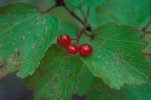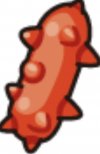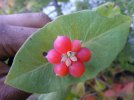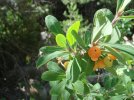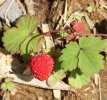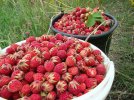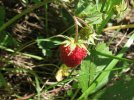Loka Forums
Type /register while in-game to register for a forums account.
You are using an out of date browser. It may not display this or other websites correctly.
You should upgrade or use an alternative browser.
You should upgrade or use an alternative browser.
Posting a different fruit every day until we obtain a Crypt head
- Thread starter Evil_X
- Start date
January 24th, Day 979: Alpine Honeysuckle
Fruit Info: “Lonicera alpigena L., known as alpine honeysuckleis a species of honeysuckle native
to mountain forests of Central and Southern Europe. It is sometimes cultivated as an ornamental plant outside its native range. It is a deciduous shrub up to 2 m high, and in late summer, bears conspicuous brilliant red inedible fruits superficially resembling cherries. L. glehnil, F. Schmidt, which is native to Sakhalin. Kurile Island.Hokkaido and Honshu is sometimes considered as a geographically disjunct subspecies of alpine honeysuckle, L. alpigena L. subsp. glehnii (F. Schmidt) H. Hara”.
Fruit Tier: A

Fruit Info: “Lonicera alpigena L., known as alpine honeysuckleis a species of honeysuckle native
to mountain forests of Central and Southern Europe. It is sometimes cultivated as an ornamental plant outside its native range. It is a deciduous shrub up to 2 m high, and in late summer, bears conspicuous brilliant red inedible fruits superficially resembling cherries. L. glehnil, F. Schmidt, which is native to Sakhalin. Kurile Island.Hokkaido and Honshu is sometimes considered as a geographically disjunct subspecies of alpine honeysuckle, L. alpigena L. subsp. glehnii (F. Schmidt) H. Hara”.
Fruit Tier: A

Not going to lie, I thought you had photoshopped faces onto those berries at first glance.January 24th, Day 979: Alpine Honeysuckle
Fruit Info: “Lonicera alpigena L., known as alpine honeysuckleis a species of honeysuckle native
to mountain forests of Central and Southern Europe. It is sometimes cultivated as an ornamental plant outside its native range. It is a deciduous shrub up to 2 m high, and in late summer, bears conspicuous brilliant red inedible fruits superficially resembling cherries. L. glehnil, F. Schmidt, which is native to Sakhalin. Kurile Island.Hokkaido and Honshu is sometimes considered as a geographically disjunct subspecies of alpine honeysuckle, L. alpigena L. subsp. glehnii (F. Schmidt) H. Hara”.
Fruit Tier: A
I didn’t even notice that when I first posted it. That’s actually hilarious.Not going to lie, I thought you had photoshopped faces onto those berries at first glance.
January 25th, Day 980: Bell’s Honeysuckle,
Fruit Info: Today’s fruit of the day is Bell’s Honeysuckle, Lonicera x bella. This fruit was originally bred and grown in captivity but escaped and has become a wide spread invasive species in North America.
Fruit Tier: B
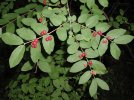
January 26th, Day 981: Blue Honeysuckle
Fruit Info: For our fruit of the day today we have the blue honeysuckle. This fruit is a native throughout cool and temperate regions of North America, Asia, and Europe. This fruit can be used in jellies, jams, sauces, yogurts, creams, and a variety of pastries. This fruit also usually ripens about two weeks before strawberries do.
Fruit Tier: B
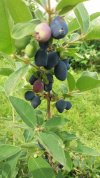
Fruit Info: For our fruit of the day today we have the blue honeysuckle. This fruit is a native throughout cool and temperate regions of North America, Asia, and Europe. This fruit can be used in jellies, jams, sauces, yogurts, creams, and a variety of pastries. This fruit also usually ripens about two weeks before strawberries do.
Fruit Tier: B

January 28th, Day 983: Bearberry Honeysuckle
Fruit Info: Today’s fruit is the Bearberry Honeysuckle, known scientifically as Lonicera involuncrata. This fruit gets about 6 - 12mm in diameter and ripens in mid to late summer. As you may have guessed, the berries here are a type of food for bears out in nature.
Fruit Tier: B
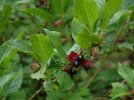
Fruit Info: Today’s fruit is the Bearberry Honeysuckle, known scientifically as Lonicera involuncrata. This fruit gets about 6 - 12mm in diameter and ripens in mid to late summer. As you may have guessed, the berries here are a type of food for bears out in nature.
Fruit Tier: B

January 29th, Day 984: Japanese Honeysuckle
Fruit Info: For the fruit of the day today we have Lonicera japonica. This fruit is obviously from Japan but is native to other regions of Asia too. It has since become an invasive species around the world. This fruit has the potential to be fairly toxic to humans.
Fruit Tier: B

Fruit Info: For the fruit of the day today we have Lonicera japonica. This fruit is obviously from Japan but is native to other regions of Asia too. It has since become an invasive species around the world. This fruit has the potential to be fairly toxic to humans.
Fruit Tier: B

January 31st, Day 986: Amur Honeysuckle
Fruit Info: For our fruit of the day today we have the Amur Honeysuckle, Lonicera maackii. This fruit is a native to Western Asia, specifically in the temperate regions. Overtime it has become an invasive species in many locations including the United States.
Fruit Tier: B
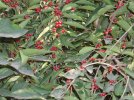
Fruit Info: For our fruit of the day today we have the Amur Honeysuckle, Lonicera maackii. This fruit is a native to Western Asia, specifically in the temperate regions. Overtime it has become an invasive species in many locations including the United States.
Fruit Tier: B

February 1st, Day 987: Morrow’s Honeysuckle
Fruit Info: For the fruit of the day today we have the morrow’s honeysuckle, Lonicera morrowii. This fruit of the day is native to Japan, Korea and Northeast China. These berries are frequently eaten by birds but are considered poisonous to humans.
Fruit Tier: C
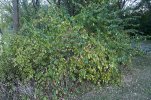
Fruit Info: For the fruit of the day today we have the morrow’s honeysuckle, Lonicera morrowii. This fruit of the day is native to Japan, Korea and Northeast China. These berries are frequently eaten by birds but are considered poisonous to humans.
Fruit Tier: C

February 2nd, Day 988: Tatarian Honeysuckle
Fruit Info: “Lonicera tatarica is a species of honeysuckle known by the common name Tatarian honeysuckle. Native to Eurasia, the plant is one of several exotic bush honeysuckles present in North America, being considered an invasive species there” - Wikipedia
Fruit Tier: B
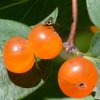
Fruit Info: “Lonicera tatarica is a species of honeysuckle known by the common name Tatarian honeysuckle. Native to Eurasia, the plant is one of several exotic bush honeysuckles present in North America, being considered an invasive species there” - Wikipedia
Fruit Tier: B

February 3rd, Day 989: Fragaria daltoniana
Fruit Info: For today our fruit of the day is a type of strawberry that is a native of the Himalayas. While sll strawberries have a base haploid count of 7 chromosomes, this fruit is a diploid bringing it up to 14 chromosomes. Also apparently this fruit is as tasty as it looks because according to Wikipedia “Its fruit has a poor flavor, and is of no commercial value.”
Fruit Tier: S
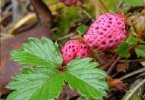
Fruit Info: For today our fruit of the day is a type of strawberry that is a native of the Himalayas. While sll strawberries have a base haploid count of 7 chromosomes, this fruit is a diploid bringing it up to 14 chromosomes. Also apparently this fruit is as tasty as it looks because according to Wikipedia “Its fruit has a poor flavor, and is of no commercial value.”
Fruit Tier: S

February 6th, Day 992: Fragaris vesca
Fruit Info: For our fruit of the day today we have another diploid cousin of the strawberry. Sometimes referred to as the alpine strawberry, this fruit is produced continuously throughout the summer by its plant. Hundreds of tons of this fruit are grown every year in Turkey, primarily as an export.
Fruity Tier: S
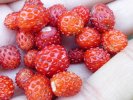
Fruit Info: For our fruit of the day today we have another diploid cousin of the strawberry. Sometimes referred to as the alpine strawberry, this fruit is produced continuously throughout the summer by its plant. Hundreds of tons of this fruit are grown every year in Turkey, primarily as an export.
Fruity Tier: S

Install the app
How to install the app on iOS
Follow along with the video below to see how to install our site as a web app on your home screen.
Note: This feature may not be available in some browsers.

